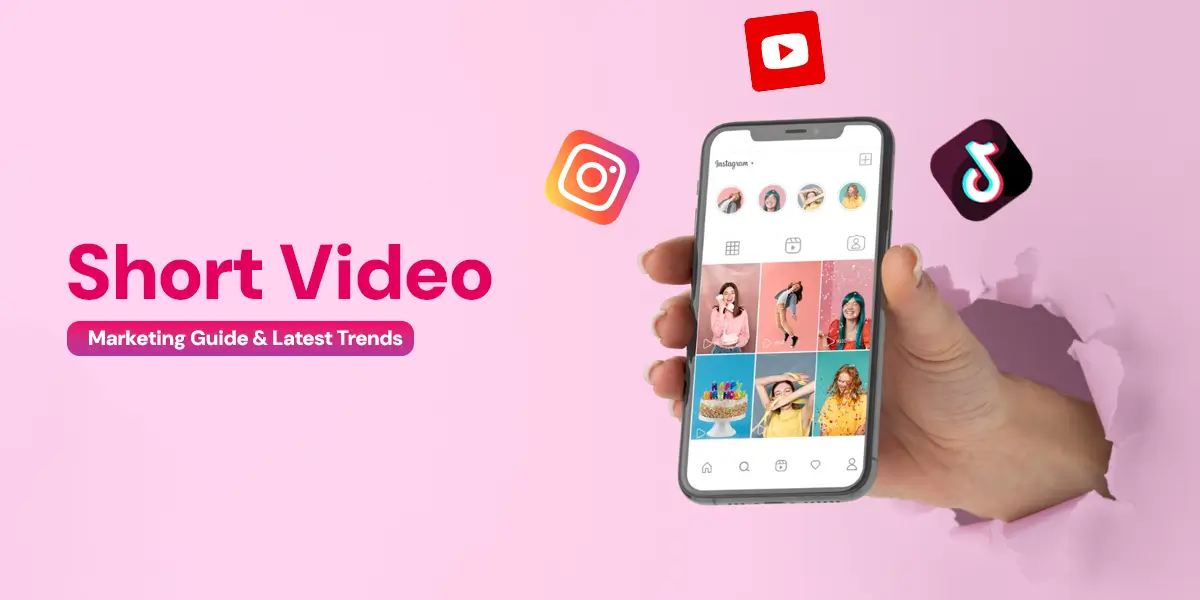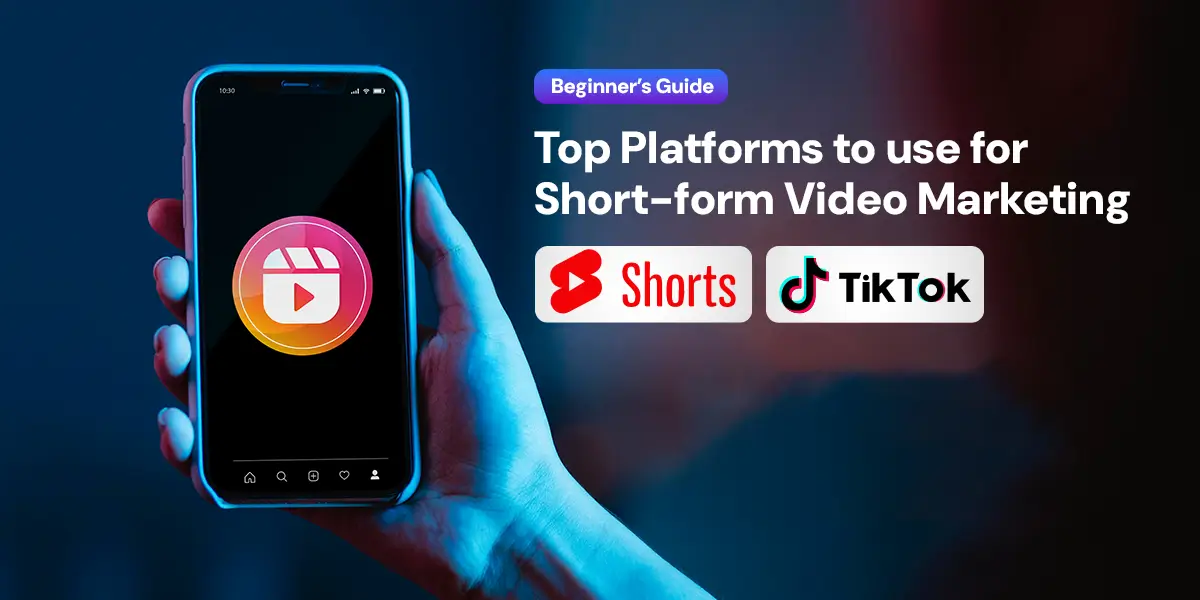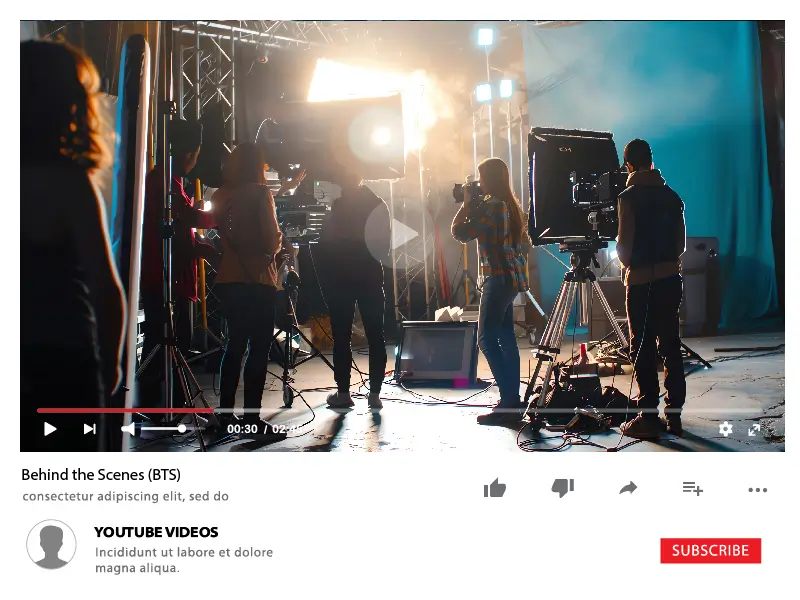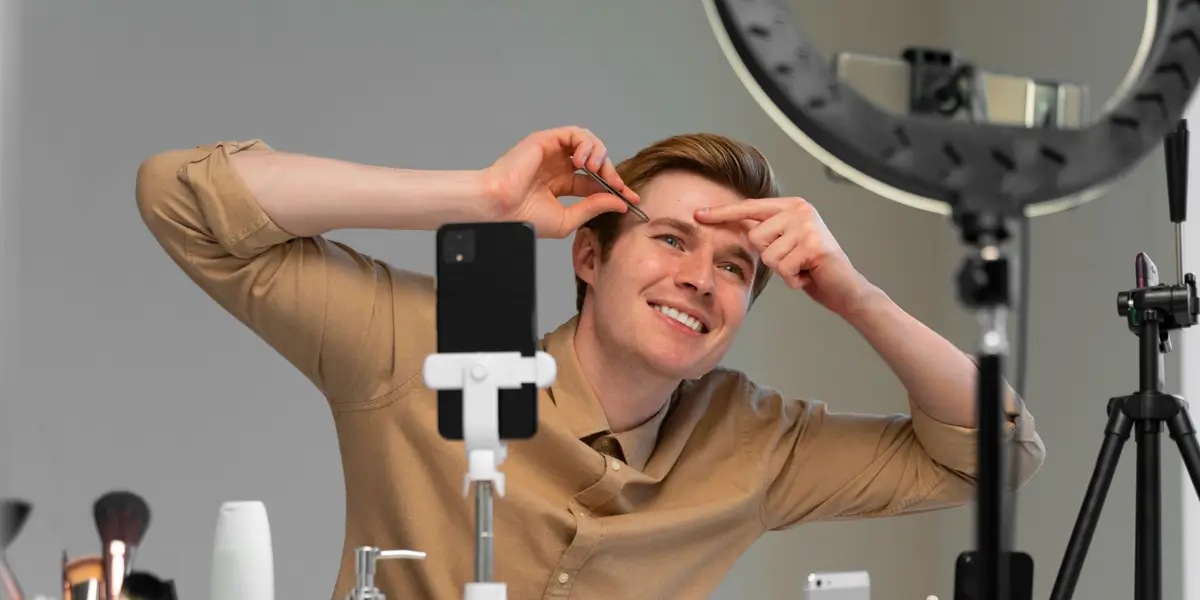Short Video Marketing Trends Every Marketer Needs
Short-from video content is growing in popularity among social media platforms. The evidence lies in the fact that Meta and YouTube had to launch Instagram Reels and Shorts (respectively) to compete with the fast-growing TikTok. These platforms keep changing the upper limit on the duration of their videos, but the fact remains that more and more people are leaning towards shorter content formats.

Even viral videos are usually short – not more than 10 to 15 seconds long. Even if a long-form video is interesting, the catchiest bits are posted as short clips to increase the chances of going viral. So, if you want to use them to your advantage, this short video marketing guide should help you get the best results.
What are short-form videos?
The definition of short-form videos differs from platform to platform. But generally, videos that are 60-90 seconds or less are considered short videos. However, there are some that consider even 3-minute long videos as short videos. But the main characteristics about a short video are that they are easy to consume pieces of content that give the viewer all the information they need in a short span of time.
People these days have busy schedules, yet they wish to consume as much content as possible in the little free time that they have. How many times have you skipped a video after watching it for just a few short seconds? Unless the content is something you are truly interested in, you won’t want to spend more time on it. Moreover, there are so many videos that deal with the same content. Wouldn’t you rather watch a short video that gives you all the information you need than watch a longer video that basically has all the same information?
Now it’s much easier to understand why shorter videos are getting more popular these days.
But, why are short-form videos important for marketers?
It’s been stated over and over again that people’s attention spans are reducing and they are showing more preference for shorter content. That’s why even YouTube introduced Shorts so content creators could hook more viewers with glimpses of their videos. It also gave a chance to more creators who prefer making shorter videos.
So, how does making shorter videos benefit you as a marketer?
Let’s go over some statistics about short video content:
- About 96% of consumers prefer learning about a product or service through short videos.
- Short videos provide the highest ROI compared to other formats and are the best for generating leads and engagement.
- About 30% of short videos are watched 81% through.
- It is agreed by 47% of marketers that it is more likely that short videos will go viral.
As a marketer, virality can be a tempting reason to opt for shorter videos, but you must consider that there are many more benefits than just going viral.
Benefits of making short-form videos
-
Better engagement
Short-form videos have more engagement compared to longer ones. Not only do people tend to watch them all the way through, but they also engage through likes, comments, and shares.
-
Supports SEO efforts
It is easier to rank on SERPs with short videos. When you are constrained by a time limit on your content, you tend to leave out all the unnecessary information or “fluff” so that the viewer gets exactly what they want. And when the viewer’s need (education, entertainment, etc.) is met in a few seconds or minutes, your videos will organically rank at the top.
-
Easy content repurposing
Content repurposing gets easier, especially on platforms that don’t support long videos. Even YouTube makes it easier to repurpose content as you can upload sections of a longer video as YouTube Shorts and then link them back to the main video.
-
Better ROI than longer videos
The return on investment (ROI) is much better when compared to longer videos. It takes a lot of resources to make a video. You need time, equipment, manpower, and money and the need for resources only grows with the length of your videos. When you know that your viewers respond better to shorter content, you can maximize your returns with short videos.
Top platforms to use for short-form video marketing

Video marketing these days is considered to be part of social media marketing. The reason for this is because most of video marketing is geared towards drumming up engagement and advertising on social media platforms. Of the platforms for social media marketing, the following are the most popular among marketers:
-
Instagram and Facebook
Both Instagram and Facebook are owned by Meta and have been popular with many different generations, although Instagram seems to be preferred among the newer generations. To compete with the quickly rising TikTok, Instagram Reels (also available on Facebook) was launched in 2020 to encourage users to post short-form video content.
Very soon, Reels became very popular with the algorithm thanks to the format and the use of trending music. Instagram Reels are so popular that it has its own button at the bottom of the app that is feed for Reels exclusively. Moreover, after the launch of Reel ads in 2021, you can use video marketing to reach more potential customers and followers on the platform. Even if you want to reach your target audience organically, Reels work out much better than still images as you can leverage the trending songs to be discovered.
-
YouTube
YouTube (launched in 2005) is only second to Facebook when it comes to being the most popular social media platform. However, it has mostly been used for long-form videos. Things changed with a surge in demand for short-form video content thanks to TikTok and Instagram Reels. And that’s why YouTube Shorts was launched soon after Instagram Reels, in September 2020.
Launching Shorts really paid off for YouTube because they reached a daily view count of 70 billion in 2023 according to reports. When talking about long-form vs. short-form YouTube videos, Shorts even outperforms in engagement. On average, YouTube Shorts are seen to have nine times more interactions than the regular videos uploaded to the platform. Knowing about the ideal YouTube shorts length is crucial to reach the target audience more effectively.
Many corporations already utilize the platform to advertise, and with these results, it’s no wonder that more marketers are getting interested in the platform with an estimated 66% of marketers planning to increase their YouTube use for campaigns.
-
TikTok
Unlike the other platforms mentioned before, TikTok was exclusively for short videos. Since its launch in 2016, however, the maximum limit for a TikTok video has increased drastically (from 10 minutes to 60 minutes long). But the consensus by most famous TikTokers is that the ideal length for a TikTok video is 10 to 17 seconds long.
TikTok has been giving these other platforms a tough competition however its complete/partial ban in various countries has hampered its growth. Still, TikTok is still popular with many people who even use TikTok to search for answers (especially in the US).
Adobe found that about 54% of businesses use TikTok to promote their brand and products. And that is exactly why TikTok marketing has become a thing among marketers.
So, now that we’ve established what platforms are best for video marketing, what kind of videos should what kind of videos should you make and upload? A good way to understand what kinds of videos to make is by looking at the various trends and filming and editing content for social media.
Short video marketing trends to look out for in 2026
-
Influencer marketing

When it comes to social media marketing, the first instinct for many marketers is to look for collaborations with popular influencers. Influencer marketing is a video marketing trend that started a while ago, but has still not died down. As a matter of fact, the use of influencers for advertising is only increasing.
If you too want to get an influencer to promote your brand or services, or sport your products regularly, there are a few things you should keep in mind:
- Pick an influencer who operates in your niche or makes content that is related to your niche. This isn’t a hard and fast rule, but it makes more sense for, say, a beauty influencer to promote cosmetics rather than a football player.
- Ensure that they are not involved in any controversies and that their values align with those of your brand. For example, if you are selling 100% vegan products, you’d want to collaborate with an influencer who is a well-known vegan or advocates for animal rights.
- Always communicate your expectations to the influencer and make sure that you’re both always on the same page.
-
ASMR videos

If you’ve spent a good amount of time scrolling through Instagram Reels or YouTube Shorts, you would have most certainly come across at least one ASMR video. They’re usually pretty short and run only for a few seconds. ASMR is short for autonomous sensory meridian response. It’s a term used to describe the tingling, static-like, or goosebumps sensation you get as a response to specific audio or visual triggers.
ASMR videos are on the rise on social media. YouTube alone has around 5.2 million ASMR videos from different parts of the world, so it’s safe to say that there is a global appeal. You’ll find ASMR content incorporated in content types such as beauty, unboxing videos, art and crafts, baking, etc. For example, unboxing videos where even the most minute sounds are amplified, such as paper tearing, popping of the bubble wrap, tapping on the box, etc.
Believe it or not, there are many people who like listening or watching ASMR content. According to UCLA Health, at least 20% of the population responds to some or the other form of ASMR triggers, and there is apparently an increase in interest for such content.
You can definitely try including ASMR in your video marketing. Just remember that creativity is key here. You don’t want your videos to be just like any other ASMR video on social media.
-
Behind-the-scenes (BTS) videos

Behind-the-scenes videos are a way for celebrities, icons, and even businesses, to break the ice with their followers (and customers in the case of corporations). It’s a method of showing your human side and building a bond of trust and understanding with the viewers.
Through BTS videos, you can show how your products are made, what a work day for one of your employees’ looks like, how you provide services, and so on. And, since you are trying to build a personal connection with the viewers, use real people from your company, not actors or influencers (and especially not AI-generated avatars). Include some candid moments and score them with the right music to make the content more appealing.
BTS videos tend to be a little long, but when you use this style in a short-form video, it becomes more shareable and appeals to a wider audience.
-
Product teasers

If you want to quickly generate buzz about a soon-to-be-launched product, like a phone or car, you can do so with product teasers. They are very similar to movie teasers, but they give the viewers a hint of what the product looks like, highlight some of the features, and entice the customers “stay tuned” for a product that’s “coming soon”.
Product teasers are a special for of video content as there is a great creative freedom for the video editing professionals to play around with the visuals. The main objective of a teaser is to pique the viewers’ interest, and you can do this with really slick editing skills and an imaginative mind.
-
Soundless videos

According to various sources, 85% of Facebook videos, 40% of Instagram videos, and 80% of LinkedIn videos are played on mute. This may be because many people scroll through their social media feeds in the office, in waiting rooms, or while travelling. In certain situations, videos with sound can be a bit annoying, especially when the auto-play is on and you aren’t expecting loud sounds. Considering that there are so many people who prefer watching muted videos, it makes sense to edit them in a way that viewers can understand the content, even without the sound.
You can still add trending music and audio to the videos, but you need to strengthen the visual storytelling to get your message across. Not all forms of videos will look good with subtitles added to them, but you can still tell a vivid story without words.
-
Vertical videos

Most social media content is consumed on smartphones. That’s why YouTube Shorts, TikToks, and Instagram Reels are in the 9:16 aspect ratio, so the viewer is not bothered by black bars. Consequentially, vertical videos have become the norm for short-form video making. If you are making a short video from scratch, you should film the videos vertically so it is easier for your editor to edit the footage. If you are repurposing a longer video that is in landscape mode (16:9 aspect ratio), you need to edit the footage in a way that the relevant people and objects are within the frame at the appropriate time.
-
User-generated content

User-generated content is one of the best ways to drum up organic traffic and engagement in video marketing. Unlike the other content types, these videos are made by users and customers of your brand. When customers and users make videos of themselves using your products or services, it makes other people curious about your business too. It works in a way that’s similar to word of mouth; however, in this case you may need to incentivize the users.
How do you encourage customers to make videos?
- Conduct giveaways and encourage your followers to create short videos to participate.
- Conduct a competition and give the winners free products, vouchers, discounts, etc.
- Interact with customers and followers on social media.
- Pick a random customer or user to comp on a special occasion.
- Partner with local NGOs or charities for a humanitarian cause.
If you are finding it difficult to convince followers and users to make short-form video content, you can always turn to your employees for help. Videos made by employees also counts as user-generated content as they usually depict a company’s values and culture.
It’s now time to discuss some best practices when making short videos before you jump on any of the video marketing trends we just went through.
Short-form video content best practices
- The very nature of trends is that they change with time, society, and technological development. So, you have to be vigilant and watch out for the new video marketing trends and use those that are most in line with your business and values.
- Short videos don’t automatically make people watch the full video, no matter how short they are. You need to have a good hook in the first 3-5 seconds of the video to make the viewer watch right through to the end.
- Make content that’s relevant to your niche, brand, values, and target audience.
- Post content consistently; not only so your videos get recommended to more viewers, but also so that you don’t lose the viewers and followers you already have. Make a content posting schedule and stick to it as much as possible. If you can, prepare the videos in advance so you don’t miss posting on the selected days.
- If you already have long form videos, repurpose the content by creating short highlight videos or snippets. In this manner, you will have plenty of content to work with, you don’t have to stress yourself for content ideas, and you can get the most out of your investments. Who knows? Maybe the short-form versions might do better than the longer videos.
- Unless you are making tutorials or explainer videos, try to keep the video length to a maximum of 60 seconds. If you can, you can even get it down to 15 seconds long. Just ensure that you convey your message effectively.
- Make strategic use of your captions. This is where you typically add context, more information, keywords, and calls to action, among other details that you can’t include in the video.
To summarise…
The amount of time people spend online is growing. And as a marketer, this is the best ground for you to connect with your target audiences. While still posts and carousels do get traction on social media, video marketing is far more effective at resonating with the people and getting you the results you need. Short-form video content is especially instrumental as more and more people are showing a preference for shorter content. The platform sometimes doesn’t matter. You can debate which is better: YouTube Shorts vs Instagram Reels or Reels vs TikToks. But at the end of the day, your videos need to have a hook, be relevant to your business, and be in trend to interest the viewer.




